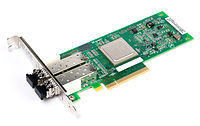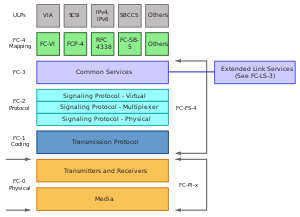Storage area network
| Computer network types by scale |
|---|
 |
Fibre Channel 8b/10b encoding | |
|---|---|
| Layer 0. Physical |
A storage area network (SAN) or storage network is a
Although a SAN provides only block-level access,
Newer SAN configurations enable hybrid SAN[1] and allow traditional block storage that appears as local storage but also object storage for web services through APIs.
Storage architectures

Storage area networks (SANs) are sometimes referred to as network behind the servers
DAS was the first network storage system and is still widely used where data storage requirements are not very high. Out of it developed the network-attached storage (NAS) architecture, where one or more dedicated file server or storage devices are made available in a LAN.[3]: 18 Therefore, the transfer of data, particularly for backup, still takes place over the existing LAN. If more than a terabyte of data was stored at any one time, LAN bandwidth became a bottleneck.[3]: 21–22 Therefore, SANs were developed, where a dedicated storage network was attached to the LAN, and terabytes of data are transferred over a dedicated high speed and bandwidth network. Within the SAN, storage devices are interconnected. Transfer of data between storage devices, such as for backup, happens behind the servers and is meant to be transparent.[3]: 22 In a NAS architecture data is transferred using the TCP and IP protocols over Ethernet. Distinct protocols were developed for SANs, such as Fibre Channel, iSCSI, Infiniband. Therefore, SANs often have their own network and storage devices, which have to be bought, installed, and configured. This makes SANs inherently more expensive than NAS architectures.[3]: 29
Components

SANs have their own networking devices, such as SAN switches. To access the SAN, so-called SAN servers are used, which in turn connect to SAN
Host layer
Servers that allow access to the SAN and its storage devices are said to form the host layer of the SAN. Such servers have host adapters, which are cards that attach to slots on the server motherboard (usually PCI slots) and run with a corresponding firmware and device driver. Through the host adapters the operating system of the server can communicate with the storage devices in the SAN.[4]: 26
In Fibre channel deployments, a cable connects to the host adapter through the gigabit interface converter (GBIC). GBICs are also used on switches and storage devices within the SAN, and they convert digital bits into light impulses that can then be transmitted over the Fibre Channel cables. Conversely, the GBIC converts incoming light impulses back into digital bits. The predecessor of the GBIC was called gigabit link module (GLM).[4]: 27
Fabric layer
The fabric layer consists of SAN networking devices that include
When SANs were first built, hubs were the only devices that were Fibre Channel capable, but Fibre Channel switches were developed and hubs are now rarely found in SANs. Switches have the advantage over hubs that they allow all attached devices to communicate simultaneously, as a switch provides a dedicated link to connect all its ports with one another.[4]: 34 When SANs were first built, Fibre Channel had to be implemented over copper cables, these days multimode optical fibre cables are used in SANs.[4]: 40
SANs are usually built with redundancy, so SAN switches are connected with redundant links. SAN switches connect the servers with the storage devices and are typically non-blocking allowing transmission of data across all attached wires at the same time.[4]: 29 SAN switches are for redundancy purposes set up in a meshed topology. A single SAN switch can have as few as 8 ports and up to 32 ports with modular extensions.[4]: 35 So-called director-class switches can have as many as 128 ports.[4]: 36
In switched SANs, the Fibre Channel switched fabric protocol FC-SW-6 is used under which every device in the SAN has a hardcoded World Wide Name (WWN) address in the host bus adapter (HBA). If a device is connected to the SAN its WWN is registered in the SAN switch name server.[4]: 47 In place of a WWN, or worldwide port name (WWPN), SAN Fibre Channel storage device vendors may also hardcode a worldwide node name (WWNN). The ports of storage devices often have a WWN starting with 5, while the bus adapters of servers start with 10 or 21.[4]: 47
Storage layer

The serialized
The various storage devices in a SAN are said to form the storage layer. It can include a variety of
Network protocols
A mapping layer to other protocols is used to form a network:
- AT Attachment(ATA) over Ethernet
- Fibre Channel Protocol (FCP), a mapping of SCSI over Fibre Channel
- Fibre Channel over Ethernet (FCoE)
- ESCON over Fibre Channel (FICON), used by mainframe computers
- HyperSCSI, mapping of SCSI over Ethernet
- SANoIP[7]mapping of FCP over IP
- TCP/IP
- iSCSI Extensions for RDMA (iSER), mapping of iSCSI over InfiniBand
- stream socketslike TCP/IP
- SCSI RDMA Protocol (SRP), another SCSI implementation for remote direct memory access (RDMA) transports
Storage networks may also be built using
| Applications | ||||||
| SCSI Layer | ||||||
| FCP | FCP | FCP | FCP | iSCSI | iSER | SRP |
| FCIP | iFCP | |||||
| TCP | RDMA Transport | |||||
| FCoE | IP | IP or InfiniBand Network | ||||
| FC | Ethernet | Ethernet or InfiniBand Link | ||||
Software
The
SAN management software is installed on one or more servers and management clients on the storage devices. Two approaches have developed in SAN management software: in-band and out-of-band management. In-band means that management data between server and storage devices is transmitted on the same network as the storage data. While out-of-band means that management data is transmitted over dedicated links.[2]: 174 SAN management software will collect management data from all storage devices in the storage layer. This includes info on read and write failures, storage capacity bottlenecks and failure of storage devices. SAN management software may integrate with the Simple Network Management Protocol (SNMP).[2]: 176
In 1999 Common Information Model (CIM), an open standard, was introduced for managing storage devices and to provide interoperability, The web-based version of CIM is called Web-Based Enterprise Management (WBEM) and defines SAN storage device objects and process transactions. Use of these protocols involves a CIM object manager (CIMOM), to manage objects and interactions, and allows for the central management of SAN storage devices. Basic device management for SANs can also be achieved through the
Ultimately SAN networking and storage devices are available from many vendors and every SAN vendor has its own management and configuration software. Common management in SANs that include devices from different vendors is only possible if vendors make the
Filesystems support
In a SAN, data is transferred, stored and accessed on a block level. As such, a SAN does not provide
In media and entertainment
Video editing systems require very high data transfer rates and very low latency. SANs in media and entertainment are often referred to as serverless due to the nature of the configuration which places the video workflow (ingest, editing, playout) desktop clients directly on the SAN rather than attaching to servers. Control of data flow is managed by a distributed file system. Per-node bandwidth usage control, sometimes referred to as quality of service (QoS), is especially important in video editing as it ensures fair and prioritized bandwidth usage across the network.
Quality of service
SAN Storage QoS enables the desired storage performance to be calculated and maintained for network customers accessing the device. Some factors that affect SAN QoS are:
- Bandwidth – The rate of data throughput available on the system.
- Latency – The time delay for a read/write operation to execute.
- Queue depth – The number of outstanding operations waiting to execute to the underlying disks (traditional or solid-state drives).
Alternatively,
Storage virtualization
Storage virtualization is the process of abstracting logical storage from physical storage. The physical storage resources are aggregated into storage pools, from which the logical storage is created. It presents to the user a logical space for data storage and transparently handles the process of mapping it to the physical location, a concept called location transparency. This is implemented in modern disk arrays, often using vendor-proprietary technology. However, the goal of storage virtualization is to group multiple disk arrays from different vendors, scattered over a network, into a single storage device. The single storage device can then be managed uniformly.[8]
See also
- List of networked storage hardware platforms
- List of storage area network management systems
- Massive array of idle disks(MAID)
- Storage hypervisor
- Storage resource management (SRM)
- Converged storage
References
- ^ "Water Panther Expanse SAN Series | Enterprise Data Center Hard Drives & SSDs". Water Panther. Archived from the original on 18 July 2022. Retrieved 18 July 2022.
- ^ a b c d e f g h i Jon Tate; Pall Beck; Hector Hugo Ibarra; Shanmuganathan Kumaravel; Libor Miklas (2017). "Introduction to Storage Area Networks" (PDF). Red Books, IBM. Archived (PDF) from the original on 1 January 2020. Retrieved 15 September 2011.
- ^ ISBN 978-0-7897-2574-5.
- ^ ISBN 978-0-470-47134-0.
- ISBN 978-0-471-26711-9.
- ^ "TechEncyclopedia: IP Storage". Archived from the original on 9 April 2009. Retrieved 9 December 2007.
- ^ "TechEncyclopedia: SANoIP". Archived from the original on 9 April 2009. Retrieved 9 December 2007.
- ^ PC Magazine. "Virtual Storage". PC Magazine Encyclopedia. Archived from the original on 30 August 2019. Retrieved 17 October 2017.
External links
- What Is a Storage Area Network (SAN)?
- Introduction to Storage Area Networks Exhaustive Introduction into SAN, IBM Redbook
- SAN vs. DAS: A Cost Analysis of Storage in the Enterprise at the Wayback Machine (archived 2011-10-30)
- SAS and SATA, solid-state storage lower data center power consumption Archived 18 October 2010 at the Wayback Machine
- SAN NAS Videos
